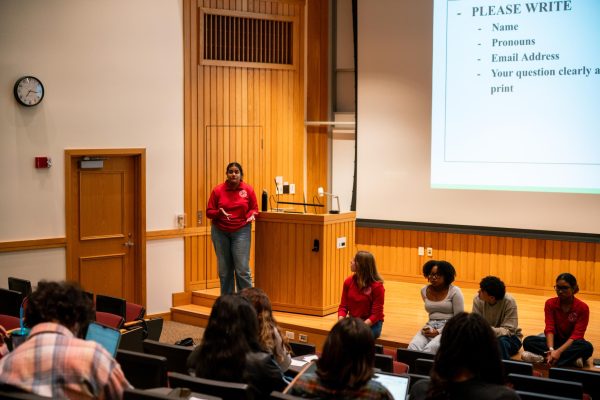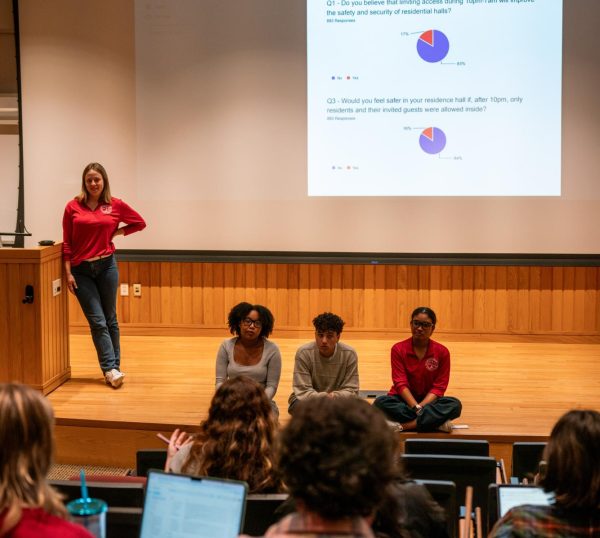Off The Cuff: Keith Tarvin, Professor of Biology
Keith Tarvin
Professor of Biology Keith Tarvin published a study last Wednesday which has been covered by major news outlets such as CNN, The New York Times, and NPR. The study, titled “Eavesdropping grey squirrels infer safety from bird chatter,” finds that squirrels use the tone of bird chatter to determine whether an environment is safe. Previous studies had only observed squirrels response to alarmed bird calls. Tarvin earned his B.A. from Hendrix College, an M.S. from the University of Arkansas, a Ph.D from the University of South Florida and did a Postdoc at the University of Chicago before coming to Oberlin in the fall of 2000 to teach Biology and Ecology. He is currently on sabbatical.
This interview has been edited for length and clarity
What has your main focus been within your research at Oberlin?
Much of my work at Oberlin has been looking at the behavioral ecology of American goldfinches. Communication is the main theme of my work. For seven or eight years now I’ve been working on squirrels and their eavesdropping behavior on alarm calls and how this works [with] other kinds of information that might be out there.
What has your experience been working at Oberlin and working with Oberlin students?
Oh, it’s a great place to be. It’s fun. Here’s the downside of working at Oberlin, and it’s a wonderful downside: Sometimes it would be great if students could spend a little bit more time in the lab, but they’ve got a recital or they’re going to go work in the circus or they’ve got a theater performance going on. That’s so cool. I love it. That’s a trade off I’ll make any day — for the eclecticism of Oberlin students and their enthusiasm and their interest in so many things. I think that’s great.
Since you’ve researched squirrel communications for so many years, I’m wondering how you envision building upon the research that you’ve just published.
This particular paper raises a few questions in my mind, some of which are kind of small but important, and others of which may be broader and more interesting to some people. First of all, even though we have pretty strong evidence that the squirrels are eavesdropping on this bird chatter, we don’t know what elements of the chatter they’re really cueing in on.
We have three different chatter exemplar recordings that we used and no squirrel received more than one. So different squirrels heard slightly different kinds of chatter. There are a couple of species of birds that were on two of the three exemplars, but I think only one species was on all three and it’s actually not a species that is found everywhere in Oberlin. The recordings were made at my house and I’m about 12 miles out of town in a different kind of habitat. So what exactly were they listening to? Were they cueing in on a particular species? Do they really categorize all bird chatter as the same thing? Which is weird because — I’ll get wonky here — a nuthatch sounds really different than a junco. Imagining that a squirrel would categorize those two kinds of sounds as one thing is interesting and kind of a stretch. So, we need to work on that and figure out, “What are the squirrels really cueing in on? What’s the mechanism by which this works?”
While your study applies to grey squirrels, I’m curious how the findings apply to our own resident albino grey squirrels.
That’s actually a really interesting question. So they are the same species, the albino squirrels are just albino gray squirrels. But on the other hand, the albino squirrels, at least to me, are really conspicuous, and if they sense that they are really conspicuous, it might be even more important for albino squirrels to make use of public information that can contribute to their safety.
I don’t know if they do. That would be a really cool study. The number of albino squirrels in Oberlin has been low for the last several years. When I first started this study, there were quite a few spread out in town and then one year, for a whole year, none of my students, who comb this area when they’re looking for squirrels, ever saw an albino squirrel, but it seems they’re slowly coming up. So I don’t think we have sample sizes big enough to look at that, but it would be really cool to find out if some individuals of a particular species have to behave differently than other kinds of individuals of the same species because of some phenotypic attributes that they have.
An NPR article made comparisons between the squirrel’s communication and Facebook or the “Twitterverse.” What do you think about that idea?
Here is an embarrassing revelation: I’ve never used Facebook or Twitter, so I don’t really know what they’re like. It’s not a bad analogy in the sense that we’re looking at one little piece of what might be a public information network. Squirrels are listening to other species — that means other species are producing information. They’re not producing it for the squirrels, they’re producing it for themselves, or for their flock mates or what have you. But the squirrels are able to exploit that information. They’re able to listen in on it. So in a sense there’s this sort of social network out there. I don’t know that it’s analogous to the social media network, but information can be transferred in various directions. It’s easy to listen in on it. It’s easy to pick up what is relevant to you and disregard what is not relevant to you. So those metaphors … I’m sure [they] have limitations, but they’re kind of cool. And I think when it’s on something like radio where you’re trying to convey something to a broad audience, that’s great. The little buzz-words get people to listen and think.









